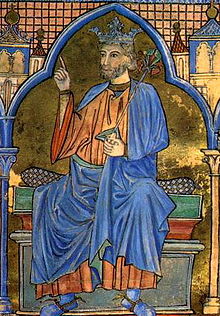Ferdinand III the Saint
| Ferdinand III | |
|---|---|

Ferdinand III in a 13th-century miniature
|
|
| King of Castile and Toledo | |
| Reign | 31 August 1217 – 30 May 1252 |
| Predecessor | Berengaria |
| Successor | Alfonso X |
| King of León and Galicia | |
| Reign | 24 September 1230 – 30 May 1252 |
| Predecessor | Alfonso IX |
| Successor | Alfonso X |
| Born | 1199/1201 Monastery of Valparaíso, Peleas de Arriba, Kingdom of Leon |
| Died | 30 May 1252 Seville, Crown of Castile |
| Burial | Seville Cathedral, Seville, Spain |
| Consort |
Elisabeth of Hohenstaufen Joan, Countess of Ponthieu |
| Issue among others... |
Alfonso X Infante Frederick Berengaria, Abbess of Las Huelgas Henry Philip, Archbishop of Seville Sancho, Archbishop of Seville Infante Manuel Eleanor, Queen of England |
| House | Ivrea |
| Father | Alfonso IX of León |
| Mother | Berengaria of Castile |
| Religion | Roman Catholicism |
| Saint Ferdinand, T.O.S.F. | |
|---|---|
 |
|
| Venerated in |
Roman Catholic Church (Third Order of St. Francis) |
| Canonized | 1671, Rome, Papal States by Pope Clement X |
| Major shrine | Seville Cathedral; |
| Feast | 30 May |
| Patronage | University of Salamanca; Cathedral of Burgos; Cathedral of Sevilla; Cathedral of La Laguna; Diocese of San Cristobal de La Laguna; University of La Laguna; of friars: (Dominican, Franciscan, Trinitarian, and Mercedarian);Lucena City, Quezon; San Fernando, California; City of San Fernando, Pampanga; Liloan, Cebu; Metropolitan Cathedral of San Fernando; (Cathedral of Resistencia, Argentina);San Fernando de Dilao Church (Pro-Cathedral of San Fernando de Dilao, Paco, Manila); of engineers |
Ferdinand III (1199/1201 – 30 May 1252), called the Saint (el Santo), was King of Castile from 1217 and King of León from 1230 as well as King of Galicia from 1231. He was the son of Alfonso IX of León and Berenguela of Castile. Through his second marriage he was also Count of Aumale. Ferdinand III was one of the most successful kings of Castile, securing not only the permanent union of the crowns of Castile and León, but also masterminding the most expansive campaign of Reconquista yet.
By military and diplomatic efforts, Ferdinand greatly expanded the dominions of Castile into southern Spain, annexing many of the great old cities of al-Andalus, including the old Andalusian capitals of Córdoba and Seville, and establishing the boundaries of the Castilian state for the next two centuries.
Ferdinand was canonized in 1671 by Pope Clement X and, in Spanish, he is known as Fernando el Santo, San Fernando or San Fernando Rey. Places such as San Fernando, Pampanga, San Fernando, La Union and the San Fernando de Dilao Church in Paco, Manila in the Philippines, and in California, San Fernando City and the San Fernando Valley, were named for him and placed under his patronage.
The exact date of Ferdinand's birth is unclear. It has been proposed to have been as early as 1199 or even 1198, although more recent researchers commonly date Ferdinand's birth in the summer of 1201. Ferdinand was born at the Monastery of Valparaíso (Peleas de Arriba, in what is now the Province of Zamora).
...
Wikipedia
